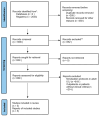Protocols for Prone Positioning in Pediatric Patients with Hypoxemia: Impact on Oxygenation, Lung Function, and Clinical Safety
- PMID: 40564701
- PMCID: PMC12191065
- DOI: 10.3390/children12060743
Protocols for Prone Positioning in Pediatric Patients with Hypoxemia: Impact on Oxygenation, Lung Function, and Clinical Safety
Abstract
Background/Objectives: This review aims to identify existing protocols and evaluate the effects of prone positioning on oxygenation and clinical outcomes in pediatric patients with hypoxemia. Methods: A systematic review was conducted in accordance with the PRISMA guidelines and registered in PROSPERO (CRD42023457270). Literature research was performed in Scopus, PubMed, Web of Science, and ScienceDirect. The final search was completed in January 2025. Results: A total of 2033 studies were identified, with 5 meeting inclusion criteria. Forty percent applied prone positioning for 12 to 20 h, improving pulmonary function. Combined with alveolar recruitment, prone positioning increased functional residual capacity and reduced atelectasis, with SpO2 improvements from 13% to 38% and atelectasis reduction from 8% to 47%. Another 40% focused on oxygenation, reporting PaO2 increases from 52 to 59 mmHg and SpO2 improvements from 93.2% to 96.2% within 2 to 4 h. One study found a significant SpO2 difference between prone (98.3%) and supine (96.2%) positions (p = 0.003). Protocols commonly included facial tilt and pillows to reduce compression. Safety measures involved checking catheter and tube placement, suspending enteral nutrition 30 min before repositioning, and hemodynamic monitoring. Adverse events were rare, including two cases of tube obstruction and one hypercapnia. No significant differences were observed in ventilation duration, oxygen therapy length, or 28-day survival between groups. Conclusions: Prone positioning improves pulmonary function and addresses refractory hypoxemia in pediatric patients. However, the optimal duration remains unclear, underscoring the need for further research to establish standardized guidelines.
Keywords: artificial respiration; lung injury; pediatrics; prone position; protocols.
Conflict of interest statement
The authors declare no conflicts of interest.
Figures
Similar articles
-
Positioning for acute respiratory distress in hospitalised infants and children.Cochrane Database Syst Rev. 2022 Jun 6;6(6):CD003645. doi: 10.1002/14651858.CD003645.pub4. Cochrane Database Syst Rev. 2022. PMID: 35661343 Free PMC article.
-
Infant position in neonates receiving mechanical ventilation.Cochrane Database Syst Rev. 2016 Nov 7;11(11):CD003668. doi: 10.1002/14651858.CD003668.pub4. Cochrane Database Syst Rev. 2016. PMID: 27819747 Free PMC article.
-
Effect of mechanical ventilation in the prone position on clinical outcomes in patients with acute hypoxemic respiratory failure: a systematic review and meta-analysis.CMAJ. 2008 Apr 22;178(9):1153-61. doi: 10.1503/cmaj.071802. CMAJ. 2008. PMID: 18427090 Free PMC article.
-
Lateral positioning for critically ill adult patients.Cochrane Database Syst Rev. 2016 May 12;2016(5):CD007205. doi: 10.1002/14651858.CD007205.pub2. Cochrane Database Syst Rev. 2016. PMID: 27169365 Free PMC article.
-
High-flow nasal cannulae for respiratory support in adult intensive care patients.Cochrane Database Syst Rev. 2017 May 30;5(5):CD010172. doi: 10.1002/14651858.CD010172.pub2. Cochrane Database Syst Rev. 2017. Update in: Cochrane Database Syst Rev. 2021 Mar 4;3:CD010172. doi: 10.1002/14651858.CD010172.pub3. PMID: 28555461 Free PMC article. Updated.
References
-
- Rocha A.D.S., Diaper J., Balogh A.L., Marti C., Grosgurin O., Habre W., Peták F., Südy R. Effect of body position on the redistribution of regional lung aeration during invasive and non-invasive ventilation of COVID-19 patients. Sci. Rep. 2022;12:11085. doi: 10.1038/s41598-022-15122-9. - DOI - PMC - PubMed
-
- Consenso para el Manejo Inicial del Síndrome de Dificultad Respiratoria en Recién Nacidos de Muy Bajo Peso. [(accessed on 8 June 2023)]. Available online: https://www.sarda.org.ar/images/2020/8_Guias.pdf.
Publication types
Grants and funding
LinkOut - more resources
Full Text Sources


